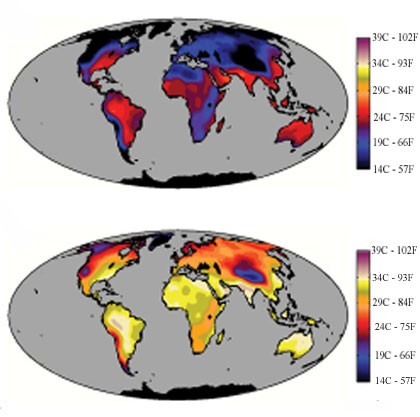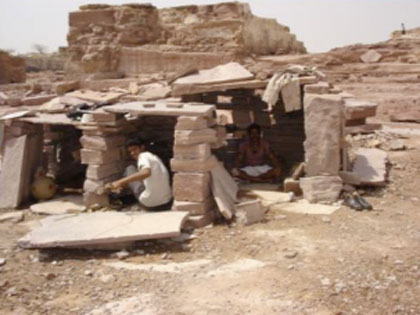Filed under: Climate Change, Future Scenarios, The Coming Transition | Tags: Climate Change, future, warming
Stuart Staniford over at Early Warning has been doing a series on climate change, specifically how as the globe gets warmer in the coming century, this warming will make some areas currently inhabited by man, uninhabitable.
Or in other words, it will be too damned hot to live there!
His first post “Odds of Cooking the Grandkids”, introduces “An adaptability limit to climate change due to heat stress”, written by Steven C. Sherwood and Matthew Huberb, published in the Proceedings of the National Academy of Sciences, online on May 3rd.
Since it costs $10 to download and read the entire paper, Staniford goes on to summarize it for us. Huberb and Staniford looked at the worse case scenarios for climate change and then compared the temperatures predicted with human tolerance for such temperatures.
Tolerances such as can we survive them.
Humans and most other mammals with a core body temperature of around 98F, need to keep that temperature within a close range. A little up or down is ok, but much more or less for any extended period of time can be damaging or fatal. Humans regulate that temperature when they are in hot environments by sweating but sweating can be effected by the humidity of the air. High humidity makes it harder for our sweat to evaporate and lessens the degree which it cools us.
This difference between the actual air temperature measured by a thermometer and the effect of humidity gives rise to something called a “wet bulb” temperature. This is the temperature a thermometer displays when it’s sensor is wrapped in a wet cloth and air is allowed to blow across it.
We know that in health people a wet bulb temperature of 95F is the limit at which we can survive. Get above that for more than a few hours and we begin to get sick and then die. Now we can survive temperatures above 95F because the humidity is almost always very low there. Dry heat, we can handle.
Currently there is nowhere on the planet that the wet bulb temperature gets above 95F, except in the rarest of situations but what happens as the climate changes and temperatures go up?

The upper globe shows what we have now with just a few degrees of climate change. The temperature scale on the right is wet bulb temperatures both current and projected.
The lower map is the expected temperatures with the worse case scenario of 11C (40F) warming. The areas in pink and white are the concern, which includes most of the eastern US, much of inland South America, Africa, India, sections of northern China, and most of Australia. Such a sharp rise will render those areas bare and lifeless as the heat drives people out, kills animals and probably all but the heartiest of plant life. Lose the plants and the soil then goes.
Remember the Dust Bowl of the early 20th century. It was caused in no small part by soil erosion. Black clouds choking off life. Imagine the Eastern United States as bare, hot and desolate as current Arizona or Nevada.
You can’t grow a garden there.
And while we are focused on the effect of high temperatures on people, don’t forget that animal livestock and agriculture will also be seriously effected. Cows will die and fields will wither.
A recent article on Daily Science points this out.
“Yields of three of the most important crops produced in the United States – corn, soybeans and cotton – are predicted to fall off a cliff if temperatures rise due to climate change.
In a paper recently published online in Proceedings of the National Academy of Sciences, North Carolina State University agricultural and resource economist Dr. Michael Roberts and Dr. Wolfram Schlenker, an assistant professor of economics at Columbia University, predict that U.S. crop yields could decrease by 30 to 46 percent over the next century under slow global warming scenarios, and by a devastating 63 to 82 percent under the most rapid global warming scenarios.
The study shows that crop yields tick up gradually between roughly 10 and 30 degrees Celsius, or about 50 to 86 degrees Fahrenheit. But when temperature levels go over 29 degrees Celsius (84.2 degrees Fahrenheit) for corn, 30 degrees Celsius (86 degrees Fahrenheit) for soybeans and 32 degrees Celsius (89.6 degrees Fahrenheit) for cotton, yields fall steeply.”
Can we say bad?
——
Does this mean that I expect this to come about?
Probably not. Nothing near the upper temperatures that they looked at in the report. Scientists after all look at the limits of things. Though, if things don’t get that worse, they can still get bad.
Even the moderate temperature increase forecasted of 1-2C or 5-7F, will make heat waves more common and with more and more happening each year, with longer and longer durations. We’ve seen that happening now. Heat related deaths are already the number one cause of weather related deaths in the US.
How much worse will it become as the planet heats up and weather grows weirder?
Something else to consider though. Not many years ago predictions for Greenland ice melt were rather conservative and now we see even worse melting than predicted. If global heat rise is worse too, this prediction may be more and more likely too.
—–
What can a Responsible Survivalist do though?
Learn to adapt and be comfortable with a bit higher temperatures. Don’t turn on the air conditioning at the first breath of Summer. Open a window instead. Its ok to sweat a little. A cool moist towel wipes it off and helps you stay comfortable.
Put on lighter clothing when you are around the house. I have several sets of used surgical scrubs that I change into when I come home from work. Lighter clothing allows air to circulate around your body and helps cool you.
Hydrate. Drink plenty of water, not sodas or caffeinated drinks like tea or coffee. Same with alcoholic beverages like beer. Caffeine and alcohol increase the effects of the heat.
Watch using fans when the humidity is high. While moving air helps cool you, by pulling the air that your sweat has evaporated into away so fresh air can replace it, when humid air is blown on you, it can prevent sweating and actually raise your core body temperature further.
Download the Red Cross pamphlet Heat Wave
And don’t forget your pets. Cats and dogs can suffer from heat related injuries just like we can. It goes without saying, don’t leave pets or children in automobiles during a heat wave. Even during moderate temperatures cars can heat up rapidly to dangerous temperatures.
Check out these articles for more about keeping pets cool:
How to Cool Your Cat Down in the Summer
Cool Off Your Dog
—–
Staniford’s second post, “Heat Stress and India” looks more specifically at the living and working in a high wet bulb environment, focusing in on India. Well worth the read especially if like me, you work in a building without air conditioning.
By the way, here’s a picture from that post of what workers at a northern Indian quarry do at mid-day. They seek shelter from the Sun in crude huts of stone.
Is this to be America in the years to come?

Leave a Comment so far
Leave a comment